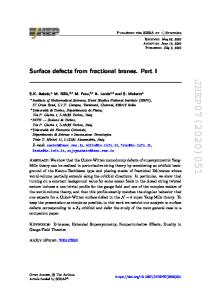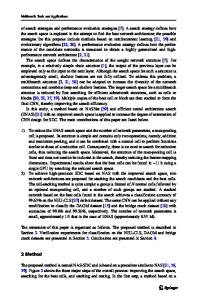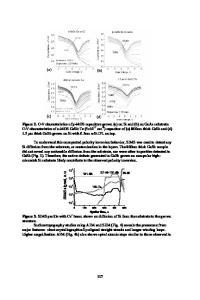Laser-Induced Surface Defects
- PDF / 439,391 Bytes
- 6 Pages / 420.48 x 639 pts Page_size
- 22 Downloads / 413 Views
LASER-INDUCED SURFACE DEFECTS Jean-Marie MOISON and Marcel BENSOUSSAN Centre National d'Etudes des T6lcommunications, D~partement OMT*, 196 rue de Paris 92220 BAGNEUX - FRANCE ABSTRACT The influence of pulsed laser processing (PLP) on the structure and composition of Si, GaAs, InP and Au surfaces has been investigated as a function of the laser fluence. Above a threshold fluence, all initial structures turn into a (lxi) structure and the V-element content of the compound surfaces is decreased. The structure change is shown to be related to the existence of a number of atomic steps on the PLP surface (up to 101 4 /cm2 equivalent broken bonds). These defects can be eliminated by further annealings. On the other hand,2 the stoechiometry defects, which are less numerous (10 -1O1 3/cm2) cannot be eliminated. A model for the mechanisms of defect creation and annihilation during PLP is outlined. The incidence of PLP-induced defects on device technology is evaluated. INTRODUCTION The study of laser-induced surface modifications is by now an active field of research. The main incidence of this topic lies in the use of pulsed-laser processing (PLP) in the fabrication or the improvement of electronic devices. On the other band, laser processing has also been demonstrated to be a powerful surface tool : it can clean very efficiently and very rapidly semiconductor surfaces, and it can induce original surface structures, which cannot be obtained by other means I 11. In this work, we have investigated under UHV conditions the evolution under PLP of the composition and structure of the surfaces of several materials, Si, Au, and A-B compounds GaAs and InP. We have determined the threshold fluence at which surface changes occur. Though this threshold is material-dependent, the nature of the change follows a general trend. It can be analyzed in terms of 1) stoechiometry defects in the case of compounds, and 2) atomic steps in all cases. The step/superstructure interaction is shown to play a major part in the surface transition obtained by PLP. EXPERIMENTAL The samples are Si (111), GaAs (100), InP (100) and Au (100) single crystals. They are chemically or electrochemically cleaned, then inserted in a UHV chamber and cleaned by repeated ion bombardments and annealings. In the case of the A-B compounds, the annealing temperature is kept low enough to prevent the surface decomposition. When all the contaminant species become undetectable by AES, the corresponding LEED patterns are the following : (7x7) for Si, c(8x2) for GaAs, (4x2) for InP, and "(5x20)" for Au. These are the room-temperature equilibrium (RTE) structures. The surface composition of the A-B compounds is found to be B-rich by AES measurements. When this RTE state is reached, the surfaces are irradiated in the UHV chamber. •he laser source is an excimer-laser-pumped dye laser. Its wavelength is 5390 A (2.3 eV), its pulse duration is 3 ns, and its repetition rate is 20 Hz. Mat.
Res.
Soc. Symp.
Proc.
Vol.
13 (1983) OElsevier
Science Publishing Co.,
Inc.
330
The bea
Data Loading...










